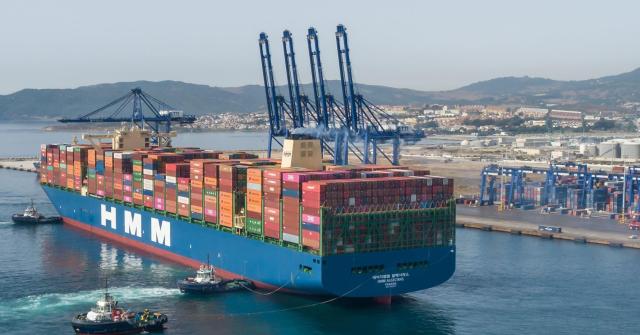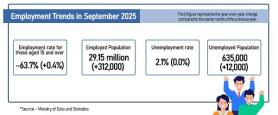
SEOUL, October 31 (AJP) - South Korea’s industrial production dipped in September as auto exports faltered under the weight of higher U.S. tariffs, but a sharp rebound in capital investment suggested that the manufacturing sector may be regaining its footing amid a global semiconductor boom and signs of easing trade frictions.
According to data released Friday by the Ministry of Data and Statistics, manufacturing output fell 1.2 percent from the previous month — the first decline since May. The drop was driven largely by an 18.3 percent plunge in automobile shipments, which more than offset a nearly 20 percent surge in semiconductor production.
Manufacturing inventories rose 2.2 percent on month, while the average factory operating rate slipped 1.2 percent, leading to a modest decline in the inventory circulation index.
The weakness in manufacturing contrasted with strength elsewhere in the economy. Service-sector output rose 1.8 percent from August, buoyed by a new round of government stimulus vouchers that spurred consumer spending. Overall industrial activity increased 1 percent on the month.
Output grew across most categories, led by a 5.8 percent increase in wholesale and retail trade, boosted by strong demand for machinery and household goods. The financial and insurance segment expanded 2.3 percent, supported by higher margin lending tied to active stock trading. By contrast, arts, sports and leisure services fell 8.4 percent, reflecting weaker consumer sentiment as households and firms shifted toward defensive, investment-oriented spending.
Retail sales slipped 0.1 percent from the previous month in September, marking the second consecutive decline. Although the pace of contraction slowed from August’s 2.5 percent drop, the figures still pointed to weakening consumer demand.
By category, sales of durable goods — including smartphones, computers, and home appliances — rose 3.9 percent, though a decline in automobile sales offset the gains.
Meanwhile, semi-durable goods such as clothing, shoes, and bags fell 5.7 percent. Nondurable goods, including gasoline and diesel, edged down 0.1 percent, extending the overall downward trend in consumption.

The outlook, however, appears more upbeat. Capital investment jumped 12.7 percent in September, reversing a 1.3 percent decline in August, as companies ramped up spending on shipbuilding and semiconductor fabrication facilities.
Machinery investment climbed 9.9 percent, while transport-equipment investment jumped 19.5 percent. A more optimistic market outlook across the manufacturing sector stimulated by a series of strong earnings reports by major South Korean companies - including Samsung Electronics and SK hynix - encouraged companies to expand capital spending.
Momentum indicators also hinted at a potential turning point. The cyclical coincident index, which measures current economic conditions, rose 0.2 points, while the leading index — a gauge of future trends — added 0.1 point, supported by firmer export and import prices and a buoyant stock market.
Experts say the combination of robust investment and resilient service activity could cushion the economy from near-term trade headwinds, particularly if semiconductor demand continues to strengthen through year’s end.
“Despite weaker investment sentiment stemming from growing domestic and global policy uncertainty, demand for high value-added memory semiconductors is expected to remain solid, supporting continued strength in the semiconductor industry through the latter half of the year," the Korea Institute for Industrial Economics and Trade noted in a report.
Copyright ⓒ Aju Press All rights reserved.

